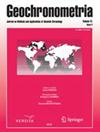烧制天然石英500°C后加热蓝色激发OSL发射的一些新特性
IF 0.9
4区 地球科学
Q3 Earth and Planetary Sciences
引用次数: 0
摘要
摘要本文报道了地质石英燃烧后500℃蓝激光激发光(OSL)的一些新特征。不同的观测结果(1)脉冲退火和(2)漂白对高温TL发光峰的影响表明510°C(升温速率为2°C/s) TL峰陷阱是造成观测到的发光的原因。该辐射的剂量学性质使其适用于kGy范围内的剂量评估。该信号很容易漂白,在125°C的蓝光下,在100秒内达到背景值。该信号通过了以下所有测试:(i)可重复性、(ii)可忽略不计的恢复和(iii)剂量恢复的准确性,这些测试是使用改进的单一当量再生(SAR)方案可靠评估辐射剂量所需的。考虑到该信号的可漂白性和高动态剂量范围,它有可能比常规OSL延长一个数量级的测年上限,相当于325°C TL陷阱。因此,综合所有的结果,这里报告的信号对于包括测量高辐射剂量的剂量学应用非常有用,比如测年。本文章由计算机程序翻译,如有差异,请以英文原文为准。
Some novel features of post-500°C heating blue stimulated OSL emission of fired natural quartz
Abstract In this study, some novel features of the post 500°C blue stimulated optically stimulated luminescence (OSL) of fired geological quartz are reported. Different observations (i) pulse annealing and (ii) impact of bleaching on high temperature TL glow peak suggested 510°C (heating rate of 2°C/s) TL peak trap to be responsible for the observed emission. The dosimetric properties of this emission were seen to make its applicability for dose assessment till kGy range. The signal was seen to be easily bleachable, reaching background value within 100 s with blue light at 125°C. The signal qualified all the tests (i) reproducibility, (ii) negligible recuperation and (iii) accuracy of dose recovery needed for reliable assessment of the radiation dose with modified Single aliquot regenerative (SAR) protocol. Considering the bleachability and high dynamic dose range of this signal, it has the potential to stretch the upper dose limit of dating by one order of magnitude than possible with conventional OSL, corresponding to 325°C TL trap. So, combining all the results, the signal reported here could be very useful for dosimetric applications involving measurement of high radiation dose, like dating.
求助全文
通过发布文献求助,成功后即可免费获取论文全文。
去求助
来源期刊

Geochronometria
地学-地球科学综合
CiteScore
2.20
自引率
0.00%
发文量
1
审稿时长
>12 weeks
期刊介绍:
Geochronometria is aimed at integrating scientists developing different methods of absolute chronology and using them in different fields of earth and other natural sciences and archaeology. The methods in use are e.g. radiocarbon, stable isotopes, isotopes of natural decay series, optically stimulated luminescence, thermoluminescence, EPR/ESR, dendrochronology, varve chronology. The journal publishes papers that are devoted to developing the dating methods as well as studies concentrating on their applications in geology, palaeoclimatology, palaeobiology, palaeohydrology, geocgraphy and archaeology etc.
 求助内容:
求助内容: 应助结果提醒方式:
应助结果提醒方式:


